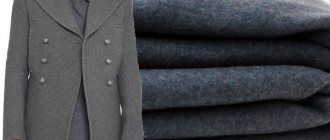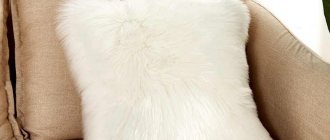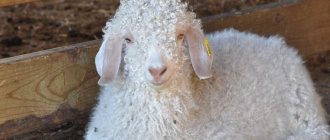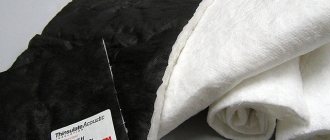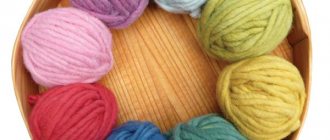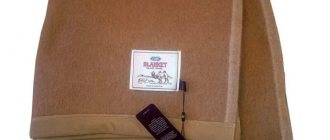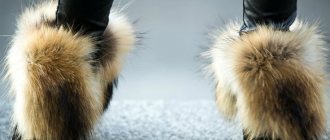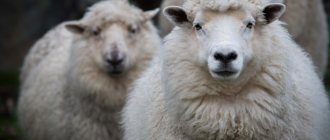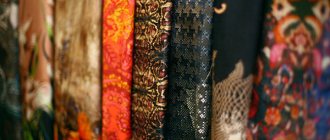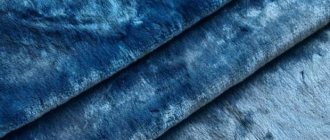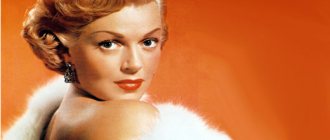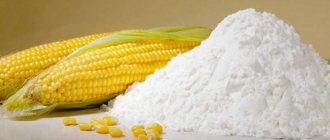Felt is a non-woven natural wool material. Felt owes its appearance to ancient cattle breeders, who noticed the unique ability of wool to felt under certain conditions. This knowledge was put into practice, with the result that canvases of different density and size were used for different purposes. Despite some loss of popularity in the 90s, over the past ten years there has been a trend towards an increase in demand for felt products. Modern designers are developing many models of clothing, shoes, and design elements. The material is no less in demand for technical needs. Like any material, felt has a number of features, advantages and disadvantages. To avoid disappointment, it is better to familiarize yourself with the main characteristics before purchasing products that are not cheap.
Features, characteristics of natural felt, what it looks like
Felt is a woolen, dense, slightly rough material with slightly protruding pile. It is very warm, cuts easily and without shedding, and may vary in thickness.
Real felt consists of sheep (less often goat) wool. Sometimes raw materials obtained from rabbits are used - in this case we are talking about a subspecies of felt, felt, from which hats and various accessories are made.
It is not uncommon to find an artificial analogue of felt on the market, which is made from polypropylene. Products made from such material are cheaper, but do not allow air to pass through well, causing excessive sweating, but at the same time they do not warm well.
Main properties of natural felt:
- Environmentally friendly - the material does not contain toxic substances, so it cannot harm humans.
- Thermal insulation. Felt fabric absorbs and removes moisture well and retains heat well. That is why felt boots are considered the warmest shoes, and walls insulated with felt ensure a normal level of humidity in the room.
- Antibacterial abilities - bacterial microflora or pathogenic fungal organisms do not multiply in felted wool fabrics.
- Lightness, which makes the material universal.
- Wear resistance.
Depending on the raw materials used in the production of felt, the fabrics can be:
- pure wool – made from wool;
- half-woolen - in addition to wool, other fibers are added that were not involved in the felting process;
- mineral - made from felt-like mineral raw materials.
Based on the quality of the fibers, the material is divided into:
- Fine-wool – widely in demand in the clothing and footwear industries, as well as the furniture industry and radio electronics. The highest quality fine wool felt is made from Australian Merino fleece. It is used for the manufacture of clothing items, accessories, interior design details, bath sets, and furniture elements. According to technological requirements, the density of the material must correspond to 0.32 (±0.02) g/cm³ and consist of natural fine sheep wool (60%), natural semi-fine sheep wool (15%), as well as fine and semi-fine wool tow, wool fine and semi-fine fur (up to 25%). No substitution of raw materials is allowed, except for the replacement of natural semi-fine wool with natural fine wool.
- Coarse-haired - marked GPrA. It is distinguished by its looseness, large thickness (up to 2.5 cm), high heat-saving and noise-insulating properties. The main components are coarse sheep and cow wool, as well as admixtures of factory and regenerated wool. It is used mainly in the engineering industries, as well as in construction.
- Semi-coarse wool - made for technical purposes, consists of the same components as coarse wool, but undergoes more thorough processing. Density – 0.28-0.34 g/cm³.
Advantages and disadvantages of textile fiber
Felt products are popular due to a number of advantages:
- safety;
- practicality;
- softness, lack of discomfort during operation;
- good heat retention;
- high air throughput;
- excellent noise and sound insulation;
- mildew resistance;
- durability;
- Possibility of use in various fields for the manufacture of a wide variety of interior items or clothing.
However, the material is not without its drawbacks, including high absorbent properties, shrinkage, and susceptibility to moth attack. This article will tell you about canvas fabric.
Modern felt production involves coating the material with lanolin, which can cause allergic reactions in people sensitive to this substance.
Production technology, material production: what is it made from?
In the old days, felt production was carried out by people with special knowledge. They laid out the wool that had been selected and cleared of various debris in a thin layer, after which they exposed it to boiling water or steam to completely clean the raw material of contaminants. After drying, the wool was laid out on sheets and periodically moistened with water to ensure complete adhesion of the fibers. The canvases had to be systematically folded and unrolled - thus the fibers fell off, turning into a homogeneous mass.
Today the technological process looks like this:
- Loosening of raw materials using pinching and scooping devices.
- Placing the prepared material into mixing equipment, where the process of oiling and mixing occurs.
- Combing on carding machines. During this processing, layers are superimposed and a web of the required dimensions is gradually formed.
- Compaction of the resulting base using equipment equipped with movable plates heated to a certain temperature.
- Impregnation with acid or alkaline solution.
- Rolling the canvas to the required thickness, density, size.
- Painting.
- Finishing of the workpiece, including pressing the canvas, cleaning it from lint, and trimming it.
- Drying the product.
Companies that value their reputation are required to send randomly selected finished fabrics to a product quality control laboratory. Read about the quality and composition of the silk-satin material here.
Interior design and architecture
The word “felt” comes from the Turkic “ojlyk”, and literally means “bedspread”. This type of material is a dense textile mass made by felting wool, which is produced using a non-woven method. Felt products have been serving people for many thousands of years, and to this day this material has not lost its relevance and popularity.
Colored felt
Advantages of felt
Felt has long been used to make carpets, clothing and shoes. At the same time, the material has several useful qualities, among which are the following:
- The ability to retain heat, that is, low thermal conductivity.
- The material allows air to pass through quite well and does not allow a large amount of moisture to linger inside the products.
- High level of sound and noise insulation of the material.
- Wide possibilities of using felt for the manufacture of various types of products.
- Felt is made from natural raw materials and is an environmentally friendly material.
Felt in a roll
Types of felt
As a rule, felt is made in the form of panels of various sizes, which also have different thicknesses. Depending on the type of products for which it is intended, felt is divided into several main types:
- Felt is a type of felt made from the finest goat or rabbit fluff.
Rolled half-woolen felt
- Velor is a type of felt covered with thick, but soft and short fibers.
Velor hat
Based on the composition of the raw materials used to make the material, felt is divided into three main types:
- Natural felt contains only natural animal hair. Depending on the degree of softness and level of processing of the wool, there are fine-wool, coarse-wool and semi-coarse-wool types of felt.
Natural felt
- Synthetic felt - consists of 100% artificial, synthetic polyester fibers.
Synthetic felt
- Technical felt is a coarse wool material made from low-grade, inexpensive natural wool with the addition of plant fibers (no more than 2.5 - 3%) and mineral impurities (no more than 0.2 - 0.5%). The dense and rough structure of the material, as well as its significant thickness, make it possible to use technical felt for the manufacture of products with a high degree of protection of metal parts during friction and vibration.
Technical felt
The history of felt
The art of felt making is based on the unique property of wool to mat and stick together when wet and shaken. This quality of wool became known to cattle breeders in ancient times, and they began to use it for practical purposes. Thus, felt products appeared long before the invention of spinning. This convenient and affordable material was used to make carpets, home coverings, shoes and clothing.
Kazakh felt carpet
Felt was especially popular among nomadic tribes because they had herds of livestock, whose wool served as the raw material for the production of the material. In addition, felt products (coverings for yurts or carpets) were relatively light in weight, and if necessary, they could be easily moved to another place.
Felt yurt of Mongolian nomads
Felt making process
The process of making felt was quite simple, but at the same time it required certain knowledge and practical skills. The animal wool selected for felting was carefully combed, carefully selecting various particles of weeds, debris and mechanical impurities.
Wool sorting process
All collected wool was then sorted by hair thickness. Afterwards, selected wool of one type was treated with boiling water in order to remove sebum and lard, as well as various contaminants.
Next, the cleaned wool had to be dried, for which it was laid out in sheets of the required size. To facilitate the adhesion of individual hairs to each other, the entire mass was moistened with water.
Felt making process
In this way, a loose fabric was obtained, which had to be rolled and unrolled several times so that the individual wool fibers gradually fell off, combining into a homogeneous, solid mass.
Depending on the thickness of the selected wool hairs and the duration of the felting process, the craftsmen received thick or thin felt, which was intended for the manufacture of various types of products.
Well felted thin felt
Thick wool produced a more durable material, which was suitable for the production of carpets, home coverings, and also for the production of shoes. But comfortable clothes were made from thin types of felt, which were generously decorated with embroidery.
Felt felt boots with embroidery
To increase the strength of the felt, a little thick wool was added to the thin wool. The resulting felt panels were decorated with embroidery, which at the same time increased the strength of the carpet or piece of clothing.
Modern felt clothing
Often, before felting, the wool was bleached, and then a pattern of wool dyed in different colors was laid out on a white background. Similar carpets continue to be made in our time, and they fit perfectly into the interior of modern apartments.
Felt carpet
The production of such products was carried out by special specialists who were called sherstobits. They constituted one of the oldest and most respected groups of artisans, and their art remains in demand to this day.
Kyrgyz felt carpets
Felt products
From ancient times to the present day, people have learned to make many types of felt products. Among the most famous and popular among them are the following:
- Valenki are a type of winter footwear, the production of which has long been widespread in Russia. According to the design features, felt boots can be either the simplest (but at the same time practical, warm and comfortable), or generously decorated with embroidered patterns or appliqué.
Felt boots made of natural felt
- Carpets are very beautiful, easy to use and durable products that harmoniously fit into an interior design made in oriental style.
Felt carpets in the design of a yurt
- Felt hats are one of the fashionable and popular accessories of a modern person. Felt hats are worn by both men and women.
Felt hat
- Burka is a sleeveless raincoat made of white, beige, red, brown or black felt. It is the national men's clothing of the peoples of the Caucasus.
Caucasian felt burka
- Syrmak is a Kazakh carpet made of felt and generously decorated with national patterns. A special feature of this type of carpet is its manufacturing technology. Syrmak is made from separate pieces of felt of different colors (most often a combination of white and black colors is used).
When forming a pattern, a mosaic technique is used, in which the pattern is cut into the base at the level of its surface, after which this composition is applied to another piece of felt and carefully quilted, and then stitched along the patterned contour with colored cord.
Kazakh felt carpet syrmak
- Shirdak is a product of Kyrgyz folk craft. Shirdak is one of the most complex carpet-making techniques. In the process of making shirdak, patterns are also cut into felt of different colors and then combined into a single colorful composition.
Kyrgyz shirdak
- The Kyrgyz cap is a special type of national headdress among the Kyrgyz and Kazakhs. It is made of thin high-quality felt and embroidered with national patterns.
Kyrgyz cap
- Covering for a yurt is a type of portable dwelling on a frame base, covered with felt on top. This type of structure is typical for Turkic and Mongolian nomadic peoples.
Kyrgyz yurt made of felt
Thus, felt has faithfully served people for centuries, and is acquiring new forms of use in various fields. Felt is also used as insulation under floor coverings. This simple technique will help bring an atmosphere of warmth and comfort to every home.
Felt floor insulation
Kinds
There are several types of felt, which are distinguished by the quality of the material, the purpose of its manufacture and further scope of application.
Needle punched (or furniture)
Dense (200-1600 g/m²) and quite thick (up to 1 cm) material, which is most often used as upholstery in the production of upholstered furniture. Read about Instroy furniture fabrics in this material.
It is a more wear-resistant alternative to batting and comes in many colors.
Yurt
It is made exclusively from natural wool fabric and is used to build yurts. Thanks to its high density, it retains heat well inside the home.
Thermal felt
It is a combination of artificial (acrylic or polypropylene) and natural (wool, linen, jute) fibers. As a rule, the part of synthetic raw materials does not exceed 40%, but each manufacturer independently decides on the percentage of components. Most often, this type of material is used to make mattresses - due to their density, thickness, and environmental friendliness, they are comfortable and durable.
Thick artificial felt
It is made entirely of polyester or polypropylene, and no weaving techniques are used during the production process - the fibers are connected to each other using glue and heat. This material is resistant to moisture, is highly flexible and elastic, and is not susceptible to rot, so it is used for both technical and domestic purposes.
Technical pure wool and its thickness
It is characterized by roughness and large thickness of the canvas (up to 3 cm). In the production process of such fabrics, low-grade varieties of wool are used, so various inclusions may be present on the surface or in the cut of the sheet, which is not a violation of the standard. There is also fine-wool technical felt, which is used to create electrical parts.
Technical coarse felt is necessary for manufacturing in the construction and engineering industries for the manufacture of insulation, gaskets, filters, and seals.
Properties of construction
It is made from coarse low-grade wool, waste from the wool industry, as well as flax tow (its specific gravity should not exceed 10%). For stronger adhesion of the fibers, it is allowed to add glue during the felting process. High-quality construction felt has a uniform structure, the same thickness over the entire area of the canvas, and does not emit a rotten or sour odor. This material is easy to cut and lay on any surface.
Shoe
It is used to make shoes and their various elements - soles, uppers, linings.
Sweat and yoke
It is used for the production of saddlery parts, for example, clamp elements, saddles, and various gaskets.
Felt - wool material
A special type of felt. Both materials are made according to the same principle, but if coarser, stiffer wool is used for felt, felt is made from soft types - fox, hare, rabbit, as well as a mixture of sheep raw materials with the downy component of the skins of small animals.
There are synthetic types of wool made from acrylic or polyester. Non-natural material is not of high quality; it is very rigid and difficult to bend, but at the same time holds its shape well. The use of felt is widespread in many areas of industry - automotive (for the production of seals, filters, polishing materials, various parts, interior upholstery), furniture (upholstery, insulation of upholstered furniture), light goods (clothing, shoes, bags, jewelry, interior items, children's goods), as well as in handicrafts. This link will tell you about the description of corduroy furniture fabric.
Filtz
A type of felt made by dry felting. To make it, wool fibers are mixed with a special serrated needle, as a result of which the wool is tangled, layer by layer, forming a fabric. This material is used in construction, mechanical engineering, in the production of musical instruments, dentistry (for grinding enamel), in the equestrian industry, in tailoring, and in the manufacture of interior parts.
Characteristics and description
Felt is a non-woven sheet material that is used in various fields. According to GOST, it can be of different densities, depending on the purpose. For the manufacture of things and handicrafts, thin, highly pressed material is used, but for construction and sound insulation of a car, greater thickness and airiness is needed. The technical characteristics of felt are its lightness and breathability.
Advantages
- Environmentally friendly and hypoallergenic, as it is made from natural materials.
- Warm. Used for making winter clothing and insulating houses.
- Antibacterial. Wool has a natural impregnation that prevents mold and insects from growing in it.
- Easy. Entire portable houses (yurts) are even made from felt.
- Wear-resistant. It does not rub or wear out for a long time.
Flaws
- Doesn't stretch. There is a technology where felt is laid on knitted items, but in itself it does not have stretchability.
- Products may shrink significantly after washing. This is a common drawback of all woolen items. But washing in cold water can prevent shrinkage.
- Mol. Natural materials, especially wool, are tasty for moths, so treat clothing with special compounds.
Scope of application of felt fabric
Technical felt fabric, depending on the thickness or density, can be used for:
- construction - as a heat insulator for the walls and ceilings of buildings, insulation of window or door openings;
- arrangement of furnaces that are used in metallurgy, as well as in the ceramic or glass business;
- technical arrangement of boiler houses, for insulation of pipelines, chimneys, heat generators.
High-quality fine-wool felt is used in the manufacture of:
- Bedding - quilts, bedspreads, mattresses.
- Valenok. These shoes are gradually coming back into fashion. Designers offer both traditional and modernized felt boots, which can be decorated with embroidery, three-dimensional patterns, and decorative stones.
- Hat.
- Buroks, which are the national clothing of the people of the Caucasus.
- Bath accessories.
- Clothing - hats, coats, sweatshirts.
- Bags.
- Carpets, which are most often made in oriental style and can complement the corresponding interior.
Varieties by purpose
- Technical – otherwise it is also called coarse-haired. It is used from second-grade wool and is used where the appearance of the product is not important. It is used in the manufacture of oil and fuel filters, as gaskets and friction protection, etc. There is also pure wool technical felt, it is made from purified raw materials.
- Construction – when building a warm house, it is necessary to insulate the walls. Artificial felt is one of the materials used. The most common type is mullite-silica, which is fire-resistant, durable and warm.
- Furniture - indispensable in the manufacture of mattresses, sofa seats and armchairs. In spring systems, the wire can pass through the filling and face fabric. To prevent this from happening, you need a dense layer. Felt copes with this.
- Yurt - the name speaks for itself; yurts are made from this type. This is a traditional Kazakh dwelling, which is lined with felt on the outside. It provides warmth and does not weigh down the structure so that the house can be easily moved.
- Self-adhesive - a material with an adhesive layer (usually double-sided tape). For example, this is used for soundproofing cars, because there is no moisture or other factors that would damage the adhesive surface.
- Shoe felt is a hard and dense felt from which the sole and main part of shoes are made.
Recommendations for caring for felt fabric products
Despite its practicality, felt requires delicate care. First of all, you need to take care of moth protection products.
High absorbent properties make them prone to absorbing foreign odors or dust, so the products require regular cleaning.
To extend the service life, it is recommended to follow these rules:
- It is strictly forbidden to wash felt in a machine - this procedure should only be carried out by hand.
- The water should be cold or warm, and the products used should be soft. It is very good if the substance used for washing contains lanolin.
- Shoes made from this material are soaked briefly and then washed, but care is taken to avoid bending. Next, the product is slightly squeezed, allowing the water to drain, gently wrung out with a towel, and dried on a shoe block.
- Do not use bleaches or aggressive stain removers to remove stains.
- Felt bags are washed in the same way. After washing, they are stuffed with newspapers - this will help maintain their shape, then dried with an iron in the “Wool” mode.
- Toys, accessories or decorative items can be dry cleaned with a brush.
- Drying is carried out away from heating devices or other heat sources.
- Felt items are best stored in paper bags.
If necessary, a felt product can be painted at home using special acrylic paints or dyes for wool. The canvas is pre-wetted, then painted with a suitable brush, applying several layers.
Origin story
The first felt appeared in the 5th-6th century BC, when wild sheep were domesticated. Their fluff contains a scaly layer that is capable of bonding the fibers to each other - the principle of felting is based on this. It was used mainly by nomadic peoples, since this material was suitable for use in construction, felting clothes and other products. There was also a belief that sheep’s wool protects against the influence of evil spirits.
Expert opinion
Alyona
Fabric expert and technologist Alena Khlebnikova is ready to answer your questions.
Write to us
Felt production became the main occupation for many peoples. At first they made things of natural color, later they began to add various dyes of natural origin:
- brown – boiled leaves and nut shells;
- pink – poppy and plum;
- yellow – onion peel;
- green – grass.
Later they learned to mix colors and create new shades. To keep the products bright longer, the color was fixed. They did this using improvised means: sauerkraut, rusty nails and copper sulfate. This allowed things not to fade, thanks to which they began to create not only monochromatic products, but also lay out variegated patterns.
One of the unique felted works of the past are patterned carpets. Even in modern times, some peoples still produce them using old technologies. There is a special device for this - a mat made of wooden rods. Unpressed dyed wool is laid out on it, creating the desired pattern. Next, the carpet is rolled together with a wooden backing, which presses it, and, if necessary, processed with felting needles.
In Russia, felt appeared in the mid-19th century in the form of felt boots. Back then, these shoes were considered elite and were worn exclusively on holidays. By the end of the 20th century, they lost their status and became an everyday type of footwear. This was due to the development of industry and cheaper materials.
Differences between felt and wool
Felt is a non-woven material, while wool fabric is created from natural fibers by weaving them, after which a fairly dense, compact material is obtained that retains heat well. Despite the common raw materials for manufacturing, wool is still inferior to felt products in its performance qualities, namely wear resistance, which is associated with the lower density of the material. At the same time, woolen fabric, like twill fabric, is characterized by better air permeability, as well as compactness (due to the absence of a large number of layers of wool fibers). Products made from this material are light, but at the same time very warm. Therefore, when choosing products, it is necessary to focus on the naturalness of their origin, as well as personal preferences. Find out about the medicinal properties of dog hair products here.
Types of technical felt
Technical sheet felt is produced in accordance with GOST, which determines its properties, technical requirements for the production process, and the finished product.
Different GOST standards are provided for different types of felt. This is due to the fact that each type is produced taking into account special requirements and is designed to solve different problems. At Promresursservice you can buy the following types of felt:
- Coarse-haired GOST 6418-81. This is a material with a thickness of 8 to 20mm. Despite its large thickness, the material has a low specific gravity and is used in mechanical engineering for cladding rooms to insulate from cold and noise.
- Semi-coarse wool GOST 6308-71. The thickness of this material varies from 6 to 20 mm. Semi-coarse wool felt is used in a wide variety of industries.
- Fine-haired 288-72. This material has a thickness of 2.5 to 20 mm. It is used in the automotive, construction, and textile industries.
The quality, properties, and price of the finished material directly depend on the raw materials used. The quality of the raw material itself is determined based on the amount of mineral and plant impurities in the wool. Perfectly white, highly purified wool is used to produce felt of the highest quality. Fine-wool felt is made from light gray raw materials with a good degree of purification from impurities. Coarse wool is made from wool with medium and minimal purity, dark and light in color.
